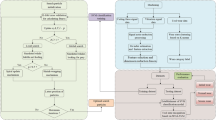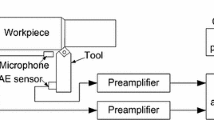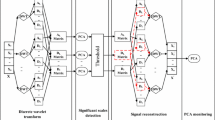Abstract
During the machining process of thin-walled parts, machine tool wear and work-piece deformation always co-exist, which make the recognition of machining conditions very difficult. Existing machining condition monitoring approaches usually consider only one single condition, i.e., either tool wear or work-piece deformation. In order to close this gap, a machining condition recognition approach based on multi-sensor fusion and support vector machine (SVM) is proposed. A dynamometer sensor and an acceleration sensor are used to collect cutting force signals and vibration signals respectively. Wavelet decomposition is utilized as a signal processing method for the extraction of signal characteristics including means and variances of a certain degree of the decomposed signals. SVM is used as a condition recognition method by using the means and variances of signals as well as cutting parameters as the input vector. Information fusion theory at the feature level is adopted to assist the machining condition recognition. Experiments are designed to demonstrate and validate the feasibility of the proposed approach. A condition recognition accuracy of about 90 % has been achieved during the experiments.









Similar content being viewed by others
References
Abellan-Nebot, J. V., & Romero Subirón, F. (2010). A review of machining monitoring systems based on artificial intelligence process models. The International Journal of Advanced Manufacturing Technology, 47(1), 237–257. doi:10.1007/s00170-009-2191-8.
Aliustaoglu, C., Ertunc, H. M., & Ocak, H. (2009). Tool wear condition monitoring using a sensor fusion model based on fuzzy inference system. Mechanical Systems and Signal Processing, 23(2), 539–546. doi:10.1016/j.ymssp.2008.02.010.
Arrazola, P. J., Özel, T., Umbrello, D., Davies, M., & Jawahir, I. S. (2013). Recent advances in modelling of metal machining processes. CIRP Annals-Manufacturing Technology, 62(2), 695–718. doi:10.1016/j.cirp.2013.05.006.
Brecher, C., Quintana, G., Rudolf, T., & Ciurana, J. (2011). Use of NC kernel data for surface roughness monitoring in milling operations. The International Journal of Advanced Manufacturing Technology, 53(9), 953–962. doi:10.1007/s00170-010-2904-z.
Castejón, M., Alegre, E., Barreiro, J., & Hernández, L. K. (2007). On-line tool wear monitoring using geometric descriptors from digital images. International Journal of Machine Tools and Manufacture, 47(12), 1847–1853. doi:10.1016/j.ijmachtools.2007.04.001.
Denkena, B., Möhring, H. C., & Litwinski, K. M. (2008). Design of dynamic multi sensor systems. Production Engineering, 2(3), 327–331. doi:10.1007/s11740-008-0102-8.
Gadelmawla, E. S. (2011). Estimation of surface roughness for turning operations using image texture features. Proceedings of the Institution of Mechanical Engineers, Part B: Journal of Engineering Manufacture, 225(8), 1281–1292. doi:10.1177/2041297510393643.
Ghani, J. A., Rizal, M., Nuawi, M. Z., Ghazali, M. J., & Haron, C. H. C. (2011). Monitoring online cutting tool wear using low-cost technique and user-friendly GUI. Wear, 271(9), 2619–2624. doi:10.1016/j.wear.2011.01.038.
Jiang, P., Jia, F., & Wang, Y. (2014). Real-time quality monitoring and predicting model based on error propagation networks for multistage machining processes. Journal of Intelligent Manufacturing, 25(3), 521–538. doi:10.1007/s10845-012-0703-0.
Li, X., Yao, Y., & Yuan, Z. (1997). On-line tool condition monitoring system with wavelet fuzzy neural network. Journal of Intelligent Manufacturing, 8(4), 271–276. doi:10.1023/A:1018585527465.
Li, X., Dong, S., & Yuan, Z. (1999). Discrete wavelet transform for tool breakage monitoring. International Journal of Machine Tools and Manufacture, 39(12), 1935–1944. doi:10.1016/S0890-6955(99)00021-8.
Li, Y., Liu, C., & Gao, J. X. (2015). An integrated feature-based dynamic control system for on-line machining, inspection and monitoring. Integrated Computer-Aided Engineering, 22(2), 187–200. doi:10.3233/ICA-150483.
Liang, S. Y., Hecker, R. L., & Landers, R. G. (2004). Machining process monitoring and control: The state-of-the-art. Journal of Manufacturing Science and Engineering, Transaction of the ASME, 126(2), 297–310. doi:10.1115/1.1707035.
Liu, T. I., Kumagai, A., Wang, Y. C., Song, S. D., Fu, Z., & Lee, J. (2010). On-line monitoring of boring tools for control of boring operations. Robotics and Computer Integrated Manufacturing, 26(3), 230–239. doi:10.1016/j.rcim.2009.11.002.
Mallat, S. G. (1999). A wavelet tour of signal processing (2nd ed.). New York: Academic Press.
Möhring, H. C., Litwinski, K. M., & Gümmer, O. (2010). Process monitoring with sensory machine tool components. CIRP Annals-Manufacturing Technology, 59(1), 383–386. doi:10.1016/j.cirp.2010.03.087.
Niu, G., & Yang, B. S. (2010). Intelligent condition monitoring and prognostics system based on data-fusion strategy. Expert Systems with Applications, 37(12), 8831–8840. doi:10.1016/j.eswa.2010.06.014.
Nouri, M., Fussell, B. K., & Ziniti, B. L. (2015). Real-time tool wear monitoring in milling using a cutting condition independent method. International Journal of Machine Tools and Manufacture, 89, 1–13. doi:10.1016/j.ijmachtools.2014.10.011.
Paul, P. S., & Varadarajan, A. S. (2012). A multi-sensor fusion model based on artificial neural network to predict tool wear during hard turning. Proceedings of the Institution of Mechanical Engineers, Part B: Journal of Engineering Manufacture, 226(5), 853–860. doi:10.1177/0954405411432381.
Peng, Z. K., & Chu, F. L. (2004). Application of the wavelet transform in machine condition monitoring and fault diagnostics: A review with bibliography. Mechanical Systems and Signal Processing, 18(2), 199–221. doi:10.1016/S0888-3270(03)00075-X.
Quintana, G., Garcia-Romeu, M. L., & Ciurana, J. (2011). Surface roughness monitoring application based on artificial neural networks for ball-end milling operations. Journal of Intelligent Manufacturing, 22(4), 607–617. doi:10.1007/s10845-009-0323-5.
Ratchev, S., Liu, S., & Becker, A. A. (2005). Error compensation strategy in milling flexible thin-wall parts. Journal of Materials Processing Technology, 162–163(15), 673–681. doi:10.1016/j.jmatprotec.2005.02.192.
Rehorn, A. G., Jiang, J., & Orban, P. E. (2005). State-of-the-art methods and results in tool condition monitoring: A review. The International Journal of Advanced Manufacturing Technology, 26(7), 693–710. doi:10.1007/s00170-004-2038-2.
Shi, D., Axinte, D. A., & Gindy, N. N. (2007). Development of an online machining process monitoring system: A case study of the broaching process. The International Journal of Advanced Manufacturing Technology, 34(1), 34–46. doi:10.1007/s00170-006-0588-1.
Snidaro, L., García, J., & Llinas, J. (2015). Context-based information fusion: A survey and discussion. Information Fusion, 25, 16–31. doi:10.1016/j.inffus.2015.01.002.
Tamizharasan, T., Barnabas, J. K., & Pakkirisamy, V. (2012). Optimization of turning parameters by using design of experiments and simulated annealing algorithm based on audible acoustic emission signals. Proceedings of the Institution of Mechanical Engineers, Part B: Journal of Engineering Manufacture, 226(7), 1159–1173. doi:10.1177/0954405412442779.
Tangjitsitcharoen, S., Saksri, T., & Ratanakuakangwan, S. (2015). Advance in chatter detection in ball end milling process by utilizing wavelet transform. Journal of Intelligent Manufacturing, 26(3), 485–499. doi:10.1007/s10845-013-0805-3.
Teti, R., Jemielniak, K., O’Donnell, G., & Dornfeld, D. (2010). Advanced monitoring of machining operations. CIRP Annals-Manufacturing Technology, 59(2), 717–739. doi:10.1016/j.cirp.2010.05.010.
Widodo, A., & Yang, B. S. (2007). Support vector machine in machine condition monitoring and fault diagnosis. Mechanical Systems and Signal Processing, 21(6), 2560–2574. doi:10.1016/j.ymssp.2006.12.007.
Wuest, T., Irgens, C., & Thoben, K. (2014). An approach to monitoring quality in manufacturing using supervised machine learning on product state data. Journal of Intelligent Manufacturing, 25(5), 1167–1180. doi:10.1007/s10845-013-0761-y.
Yoshioka, H., Shinno, H., & Sawano, H. (2014). Monitoring of distance between diamond tool edge and workpiece surface in ultraprecision cutting using evanescent light. CIRP Annals-Manufacturing Technology, 63(1), 341–344. doi:10.1016/j.cirp.2014.03.129.
Yu, J., Xi, L., & Zhou, X. (2008). Intelligent monitoring and diagnosis of manufacturing processes using an integrated approach of KBANN and GA. Computers in Industry, 59(5), 489–501. doi:10.1016/j.compind.2007.12.005.
Zhang, Y., Zhang, H., & Nasrabadi, N. M. (2013). Multi-metric learning for multi-sensor fusion based classification. Information Fusion, 14(4), 431–440. doi:10.1016/j.inffus.2012.05.002.
Zhu, K., Wong, Y. S., & Hong, G. S. (2009). Wavelet analysis of sensor signals for tool condition monitoring: A review and some new results. International Journal of Machine Tools and Manufacture, 49(7), 537–553. doi:10.1016/j.ijmachtools.2009.02.003.
Acknowledgments
The research work presented in this paper was primarily supported by the National Natural Science Foundation of China (Ref: 51375239, U1537209), and New Century Excellent Talents Supporting Plan of the Education Ministry (Ref: NCEP-13-0856).
Author information
Authors and Affiliations
Corresponding author
Rights and permissions
About this article
Cite this article
Liu, C., Li, Y., Zhou, G. et al. A sensor fusion and support vector machine based approach for recognition of complex machining conditions. J Intell Manuf 29, 1739–1752 (2018). https://doi.org/10.1007/s10845-016-1209-y
Received:
Accepted:
Published:
Issue Date:
DOI: https://doi.org/10.1007/s10845-016-1209-y




